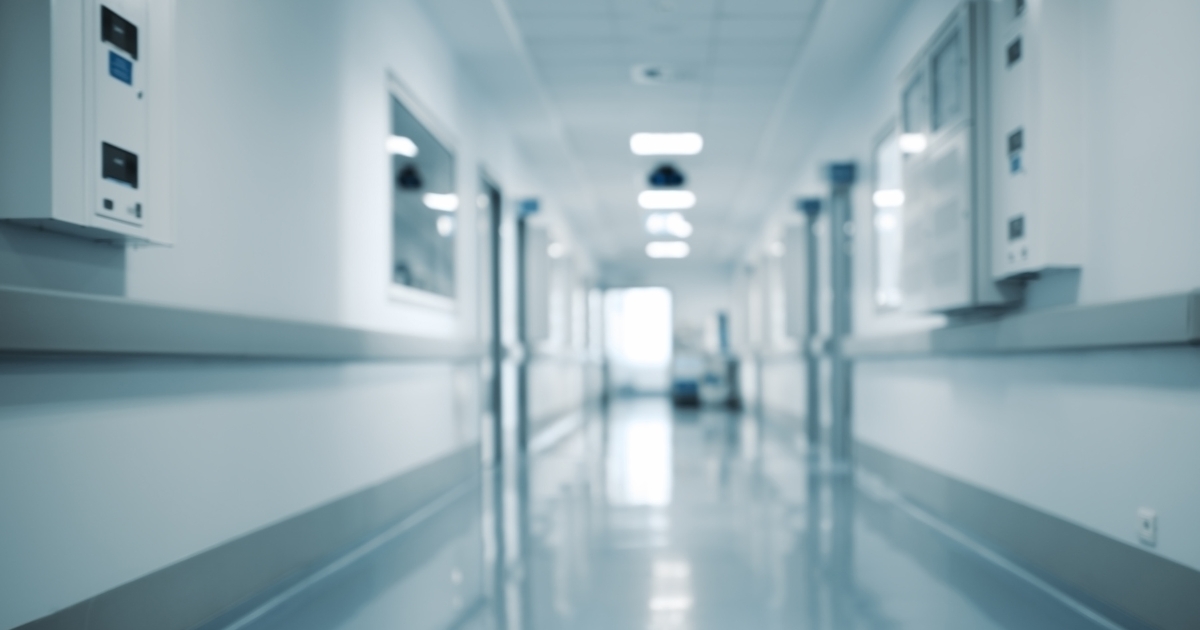Ensuring the safety of patients, staff, and visitors in healthcare facilities has never been more critical. Physical security is a foundational element of healthcare operations, combining surveillance cameras, access control, and alarms into an integrated system that protects people, sensitive data, and high-value assets. When properly implemented, these technologies strengthen compliance, support emergency response, and foster safer environments across hospitals, clinics, and long-term care facilities.
Why is physical security essential in healthcare?
Healthcare environments face complex safety challenges. They bring together a diverse mix of people—nurses, physicians, allied health staff, patients, visitors, and even newborns in maternity and neonatal units, each relying on a secure and stable setting to deliver or receive care.
A well-designed physical security strategy helps prevent workplace violence, supports rapid emergency responses, and maintains a calm, protected atmosphere throughout the facility. At the same time, healthcare organizations must safeguard valuable equipment, controlled substances, and sensitive patient information, all while operating around the clock.
Unfortunately, the risks are rising. According to the Bureau of Labor Statistics (2022), the healthcare and social assistance sectors account for 73% of all workplace violence incidents requiring days away from work. Such violence—whether physical, verbal, or psychological—drives burnout, accelerates turnover, and adds strain to already stretched healthcare systems.
A comprehensive physical security system helps deter theft and unauthorized access while creating a safe, supportive environment that allows caregivers to focus on what truly matters: delivering exceptional patient care.
.png)
What are the key components of a robust physical security system?
A robust physical security system integrates technologies and processes that control access, monitor activity, and detect or respond to potential threats within a facility. A comprehensive strategy typically includes four foundational elements: surveillance cameras, access control systems, alarms, and intrusion detection—each contributing to a layered defense that safeguards people, property, and data.
To understand how this framework functions in practice, it’s helpful to look more closely at each component and the role it plays in creating a secure, connected healthcare environment.
1. Surveillance Cameras
Surveillance cameras are the cornerstone of any physical security system. They deter potential intruders, record valuable evidence, and provide continuous visibility across the facility. In healthcare environments, they play a crucial role in maintaining patient and staff safety, ensuring accountability, and protecting sensitive areas such as pharmacies, data centers, and emergency departments. Cameras also help de-escalate incidents, support investigations, and reinforce compliance with safety and privacy standards.
What to look for:
- Resolution: Choose high-definition cameras to capture fine details for investigations.
- Night Vision: Select infrared or low-light sensors to maintain visibility 24/7.
- Placement: Cover all entry/exit points, hallways, and sensitive zones such as pharmacies or record rooms.
Types of cameras:
- Dome Cameras: Ideal for indoor environments, hallways, offices, and patient areas—or anywhere a balance of visibility and discreet design is needed. These compact, low-profile cameras offer varied resolutions up to 4K and a wide dynamic range that delivers clear imaging even in mixed lighting conditions.
- Bullet Cameras: Best suited for outdoor perimeters, parking lots, loading bays, and building entrances. Built with weatherproof, impact-resistant housings (IP67, IK10), they provide high-resolution imaging up to 4K and long-range infrared capabilities for dependable low-light visibility, serving as both a monitoring tool and a strong visual deterrent.
- Mini Series: Designed for smaller spaces such as reception areas, hallways, exam rooms, or staff lounges. These ultra-compact cameras are easy to install and feature a wide field of view for effective close-range monitoring without disrupting the environment.
- Fisheye Cameras: Ideal for large open spaces such as waiting rooms or lobbies. They deliver 360° panoramic coverage with digital dewarping, effectively replacing multiple traditional cameras while maintaining flexibility for both indoor and outdoor installations.
- Multisensor Cameras: Suited for large intersections, corridors, or areas that require multiple viewing angles from a single mounting point. Each unit includes up to four adjustable image sensors, allowing coverage in multiple directions and minimizing blind spots for high-efficiency surveillance.
- PTZ Cameras: Best for expansive outdoor areas, parking structures, or event spaces where wide coverage and zoom capabilities are critical. These cameras provide 360° continuous pan, optical zoom, and AI-assisted subject tracking—enabling responsive, real-time monitoring and superior situational awareness.
Balancing visible and discreet cameras can both deter unwanted activity and maintain patient comfort. Integrating cameras with your access control and alarm systems ensures all events are tracked in one cohesive network.
Get Full Report
2. Access Control Systems
Controlling access to sensitive areas helps prevent theft, data breaches, and unauthorized entry. Effective access control supports compliance with regulations like HIPAA, which mandates the protection of patient information.
Credential options:
- Keycards: The most common and cost-effective option. Keycards can be programmed with individual permissions, allowing staff to access only the areas relevant to their role. They are easy to distribute and deactivate if lost, making them practical for large facilities with high staff turnover.
- Biometric Scanners: Offer enhanced security by verifying a person’s unique physical characteristics—such as fingerprints, facial recognition, or iris patterns. These systems minimize the risk of lost or shared credentials and are ideal for high-security zones like medication storage or server rooms. Biometric authentication also helps maintain compliance with privacy standards by providing a verifiable record of access.
- Mobile Credentials: Enable touchless access using smartphones or wearable devices, improving both security and hygiene—an essential consideration in clinical settings. Mobile credentials can be issued or revoked remotely, reducing administrative overhead and providing real-time flexibility for managing staff and contractors.
Best practices:
- Regularly update permissions as staff roles change to ensure that only authorized individuals maintain access to restricted areas. Periodic audits help identify inactive or outdated credentials that could pose risks.
- Integrate access control with surveillance systems to create comprehensive audit trails. When an access event occurs, linked video footage can confirm the identity of the person entering, helping prevent misuse and simplifying investigations.
- Monitor access logs proactively to identify anomalies, such as repeated failed entry attempts or after-hours activity. Automated alerts can help security teams respond immediately to irregular patterns before they escalate into incidents.
Assigning specific access levels allows healthcare facilities to make sure that only approved staff can enter important areas, including surgical suites, pharmacies, and IT data rooms.
3. Alarms and Sensors
Door sensors, motion detectors, and glass break sensors form the first line of defense against intrusion. When triggered, alarms immediately alert security personnel to suspicious activity, helping protect restricted areas such as pharmacies, laboratories, and data centers. In healthcare settings, these systems play a vital role in maintaining safety and preventing unauthorized access in facilities that operate around the clock.
Common sensor types:
- Magnetic Contact Sensors: Detect when doors, windows, or cabinets are opened, tampered with, or left unsecured. These are essential for monitoring restricted areas such as medication storage or server rooms.
- Motion Sensors: Use infrared or ultrasonic technology to detect unauthorized movement within designated zones, even during low-light or after-hours conditions.
- Glass Break Detectors: Recognize the unique sound frequency of breaking glass, instantly triggering alerts when windows or entry points are compromised.
- Environmental Sensors (optional addition): Some systems now integrate temperature, humidity, or air-quality sensors to detect environmental changes that could impact patient safety or equipment integrity.
Verkada Alarms, a cloud-managed solution from Verkada, connects sensors, cameras, and monitoring tools through intelligent software that analyzes activity in real time. This integration allows security teams to respond faster, reduce false alarms, and manage multiple systems with ease.
Verkada, a leader in cloud-based physical security, combines intrusion detection, video verification, and professional monitoring within a unified interface. When a sensor is triggered, security personnel can instantly view the associated camera feed, assess the situation, and take appropriate action—all from any connected device. This coordinated approach shortens response times and ensures seamless communication between on-site teams and remote monitoring centers.
For healthcare organizations, this unified system translates to improved safety, simplified management, and greater compliance readiness. By linking alarms, cameras, and access control through one secure platform, Verkada helps facilities maintain continuous visibility and respond to potential incidents before they impact patient care.
Integrating alarms with a central monitoring system can also automate responses—such as locking doors, activating lights, or notifying local authorities—to ensure rapid containment of threats.
Get Full Report
4. Intrusion Detection Systems
Intrusion detection systems act as a key layer of defense within a healthcare facility’s security framework. They identify unusual activity, such as forced entry, after-hours movement, or tampering in restricted areas, before it escalates into a larger threat. When connected with alarms and cameras, these systems provide real-time visibility and help security teams verify and respond quickly to incidents.
A dependable intrusion detection setup helps minimize downtime, reduce false alarms, and safeguard staff confidence.
How do you determine the right physical security setup for your facility?
Before investing in any solution, conduct a comprehensive security audit. This process includes:
- Reviewing current systems and identifying weaknesses.
- Mapping high-risk zones (pharmacies, patient data storage, ER).
- Consulting security professionals for tailored recommendations.
Every healthcare facility is different. Urban hospitals face different risks than small clinics or long-term care homes. A targeted audit ensures your security investments address real-world vulnerabilities.
Integrated Security Solutions
Modern healthcare security goes beyond isolated systems. Integrated security solutions unify surveillance, access control, alarms, and analytics into a single, cohesive ecosystem.
A comprehensive integrated security framework typically includes:
- Smart Door Access Controls: Limit entry to sensitive areas.
- AI-Powered Surveillance Cameras: Detect anomalies and issue instant alerts.
- Wearable Panic Buttons: Allow staff to discreetly summon help.
- Environmental Sensors: Track air quality, temperature, and safety conditions.
- Visitor Management Systems: Verify IDs and manage entry records.
- Automated Check-In Systems: Flag risks and improve situational awareness.
- Centralized Dashboards: Provide real-time oversight across multiple sites.
The benefits include:
- Real-time monitoring and instant alerts.
- Faster, coordinated responses between security, IT, and clinical teams.
- Automated compliance reporting for audits.
- Enhanced staff safety and operational efficiency.
Integration transforms security from a reactive model into a proactive, connected network capable of protecting patients and staff more effectively than ever before.
How can healthcare facilities maintain long-term security?
Security isn’t a one-time project—it’s a continuous process. Regularly reassess risks, upgrade outdated equipment, and retrain staff. Implement a layered approach that evolves with new threats, regulatory changes, and technology advancements.
Key steps for long-term success:
- Routine audits and system testing.
- Ongoing staff training on emergency and access procedures.
- Updating credentials and permissions regularly.
- Leveraging AI analytics for predictive threat detection.
Choosing the right physical security system for a healthcare facility is a complex but essential process. Developing an effective solution starts with understanding the organization’s specific needs, selecting the appropriate security components, and ensuring they are integrated into a cohesive framework. A comprehensive security audit, supported by expert consultation, helps identify vulnerabilities and define the right mix of technology and procedures. With robust security measures in place, healthcare organizations can maintain a safe environment for patients, staff, and visitors while continuing to focus on delivering quality care.
Organizations that have implemented this integrated security model are seeing measurable results. El Centro Regional Medical Center, for instance, reduced its average investigation time from several hours to just 15 minutes and cut workplace violence incidents by over 80%—from more than a dozen each month to only one or two. These outcomes demonstrate how a unified, data-driven approach to physical security can meaningfully improve safety and operational efficiency. To explore how similar strategies could strengthen your facility, contact us to speak with a security specialist.









.jpg)
